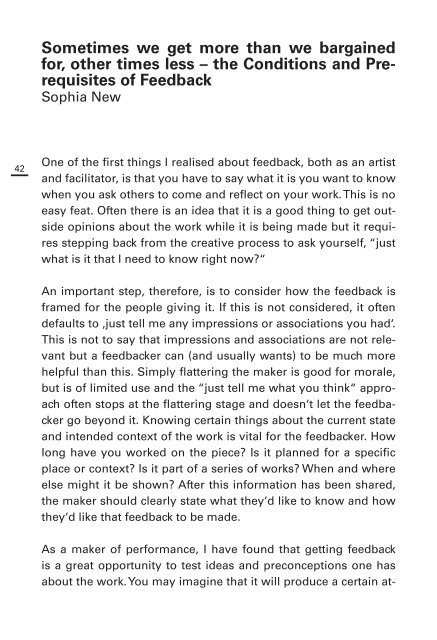Laboratory on Feedback in Artistic Processes 3
In its third edition the "Laboratory on Feedback in Artistic Processes" reflects on "Responses" within performing arts. The results of the previous Labs highlighted the need to take a closer look at the complexity and often subtle implications of feedback within the the artistic process itself. How do artist organise feedback and how do they process it? Who they want feedback from and what are its different roles? How can describe these relationships, and how does it shpae the artistic work? This booklet presents the different views on and experiences of feedback practices that were elaborated during the lab along the beforementioned questions and the insightfull contributions of its participants. Underpinning the following pages, three thematic fields have emerged: the impacts of feedback, feedback as a tool, and practicalities and contexts of feedback.
In its third edition the "Laboratory on Feedback in Artistic Processes" reflects on "Responses" within performing arts. The results of the previous Labs highlighted the need to take a closer look at the complexity and often subtle implications of feedback within the the artistic process itself. How do artist organise feedback and how do they process it? Who they want feedback from and what are its different roles? How can describe these relationships, and how does it shpae the artistic work?
This booklet presents the different views on and experiences of feedback practices that were elaborated during the lab along the beforementioned questions and the insightfull contributions of its participants. Underpinning the following pages, three thematic fields have emerged: the impacts of feedback, feedback as a tool, and practicalities and contexts of feedback.
You also want an ePaper? Increase the reach of your titles
YUMPU automatically turns print PDFs into web optimized ePapers that Google loves.
Sometimes we get more than we barga<strong>in</strong>ed<br />
for, other times less – the C<strong>on</strong>diti<strong>on</strong>s and Prerequisites<br />
of <strong>Feedback</strong><br />
Sophia New<br />
42<br />
One of the first th<strong>in</strong>gs I realised about feedback, both as an artist<br />
and facilitator, is that you have to say what it is you want to know<br />
when you ask others to come and reflect <strong>on</strong> your work. This is no<br />
easy feat. Often there is an idea that it is a good th<strong>in</strong>g to get outside<br />
op<strong>in</strong>i<strong>on</strong>s about the work while it is be<strong>in</strong>g made but it requires<br />
stepp<strong>in</strong>g back from the creative process to ask yourself, “just<br />
what is it that I need to know right now?“<br />
An important step, therefore, is to c<strong>on</strong>sider how the feedback is<br />
framed for the people giv<strong>in</strong>g it. If this is not c<strong>on</strong>sidered, it often<br />
defaults to ‚just tell me any impressi<strong>on</strong>s or associati<strong>on</strong>s you had‘.<br />
This is not to say that impressi<strong>on</strong>s and associati<strong>on</strong>s are not relevant<br />
but a feedbacker can (and usually wants) to be much more<br />
helpful than this. Simply flatter<strong>in</strong>g the maker is good for morale,<br />
but is of limited use and the “just tell me what you th<strong>in</strong>k“ approach<br />
often stops at the flatter<strong>in</strong>g stage and doesn‘t let the feedbacker<br />
go bey<strong>on</strong>d it. Know<strong>in</strong>g certa<strong>in</strong> th<strong>in</strong>gs about the current state<br />
and <strong>in</strong>tended c<strong>on</strong>text of the work is vital for the feedbacker. How<br />
l<strong>on</strong>g have you worked <strong>on</strong> the piece? Is it planned for a specific<br />
place or c<strong>on</strong>text? Is it part of a series of works? When and where<br />
else might it be shown? After this <strong>in</strong>formati<strong>on</strong> has been shared,<br />
the maker should clearly state what they‘d like to know and how<br />
they‘d like that feedback to be made.<br />
As a maker of performance, I have found that gett<strong>in</strong>g feedback<br />
is a great opportunity to test ideas and prec<strong>on</strong>cepti<strong>on</strong>s <strong>on</strong>e has<br />
about the work. You may imag<strong>in</strong>e that it will produce a certa<strong>in</strong> at-


















